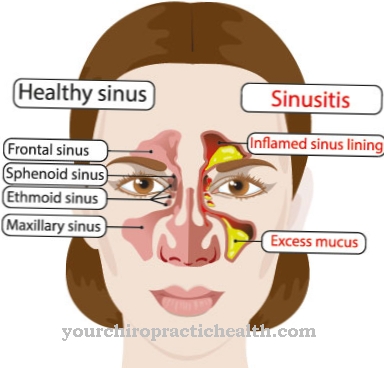Hypercapnia comes about through acidification of the blood with carbon dioxide. It ensures that the upper airways no longer function properly. If the patient is not treated as quickly as possible, in the worst case scenario carbon dioxide anesthesia and death from respiratory failure can occur.
What is hypercapnia?

© Kalim - stock.adobe.com
Under Hypercapnia medicine understands that the CO2 content in the (arterial) blood is too high. In healthy people, the arterial partial pressure is a maximum of 40 mmHg. Patients with hypercapnia have a value greater than 45 mmHg. With hypercapnia one differentiates between an acute and a chronic form.
If a person cannot exhale the carbon dioxide that is produced or inhaled as a metabolic by-product for certain reasons, it is accumulated in the blood. Then the CO2 partial pressure in the alveoli rises. The greater the acidosis (acidosis) of the blood with the gas, the more the breathing activity of the lungs is hindered.
Respiratory insufficiency (shortness of breath) occurs. Hypercapnia can also appear as a symptom of another condition, such as Pickwick's syndrome in patients with profound obesity. If respiratory failure is not treated in time, serious damage to the brain and heart occurs. In the worst case, CO2 anesthesia occurs with subsequent death from respiratory failure.
causes
Hypercapnia can have different causes.Adverse circumstances (accidents), for example, lead to inhalation of extremely CO2-containing air. CO2 rebreathing like sudden infant death syndrome (SID) can also cause hypercapnia. A metabolic alkalosis, triggered by an acute potassium deficiency, can also lead to the occurrence of excessive CO2 accumulation in the blood.
Inadequate respiratory function (respiratory insufficiency) due to damage to the alveoli (crushing of the chest as a result of an accident) or due to an obstacle in the airways are also the cause of excess acidity in the blood with CO2. Other triggers are: Damage to the respiratory center in the brain due to a cerebral infarction, impairment of the nerve pathways to the chest muscles due to paraplegia, pulmonary embolism, lung tumor, severe asthma attacks, shortness of breath due to a severe cold, severe emphysema or pneumonia.
Septic shock, certain neuromuscular disorders, use of inappropriate medication (steroids, diuretic drugs, sedatives, anesthetics), and the accidental administration of oxygen in patients with chronic obstructive pulmonary disease (COPD) can also occur.
Because of the permanent overloading of their airways, they have a high level of acidity in their blood anyway. The latter, however, requires the activation of the breath reflex. If oxygen is then accidentally supplied, the respiratory stimulus is inhibited and, in the worst case, breathing stops.
Symptoms, ailments & signs
Symptoms of mild hypercapnia include reddening of the skin, headache, clearly recognizable blood vessels, muscle twitching, increased heartbeat, and mild confusion. As the partial CO2 pressure rises, there is tremor (tremor), increased breathing as an attempt to compensate for the shortness of breath, an increase in blood pressure and dizziness.
If the person concerned then receives no help and the partial pressure rises to over 50 mmHg, seizures, sweating, heart rush, panic and hypoxia (insufficient oxygen supply to the body) occur. The heartbeat slows down, the blood pressure drops sharply. Disturbances in consciousness follow with increasing drowsiness. The patient falls into a coma (CO2 anesthesia). If no ventilation is given at this stage of hypercapnia, his lips will turn blue (cyanosis) and death will result from respiratory failure.
Diagnosis & course of disease
Hypercapnia can be determined with an arterial blood gas analysis. The pH value and the oxygen saturation of the blood are also measured. If the pH falls below 7.35, respiratory acidosis is present. Over-acidification of the blood leads to a narrowing of the blood vessels in the lungs, while at the same time those of the brain and the rest of the body expand. As a result, the potassium concentration in the blood increases, which impairs the function of the heart and can lead to cardiac arrhythmias. From a partial pressure of more than 60 mmHg, the patient falls into a coma.
Complications
Without treatment, hypercapnia can in the worst case lead to death of the patient. As a rule, the affected person dies under anesthesia caused by carbon dioxide, as the blood is extremely acidic. Ultimately, breathing stops and thus cardiac arrest as well. In acute emergencies, urgent treatment by a doctor is necessary.
Furthermore, the affected person suffers from a high heartbeat and from being well versed. Headaches also occur and the patient's skin is usually reddened. The muscles twitch involuntarily and a tremor occurs. The quality of life is extremely reduced by the hypercapnia and the person concerned also suffers from dizziness and nausea.
Not infrequently, there is also a loss of consciousness, in which the patient can also suffer injuries from a fall. Most people also have a panic attack when symptoms of hypercapnia appear. The treatment of the disease is acute in any case and must keep those affected alive.
The underlying disease must also be treated. Whether further complications arise with this treatment depends heavily on the underlying disease and can usually not be universally predicted. In most cases, however, life expectancy is reduced due to hypercapnia.
When should you go to the doctor?
If symptoms such as reddening of the skin, headache, and muscle twitching are noticed, the cause may be hypercapnia. A doctor should be consulted if these symptoms occur for no apparent reason and persist for more than three to four days. If there are other symptoms, such as an increased pulse or confusion, you must see a doctor on the same day.
If the hypercapnia remains untreated, seizures, palpitations and sweats set in - then medical advice is required at the latest. If there is an increasing disturbance of consciousness, the rescue service must be alerted. Outward signs such as blue lips, usually associated with a circulatory collapse, require immediate first aid measures. Then the person concerned must be given emergency medical care or taken to a hospital. Hypercapnia is often associated with a potassium deficiency, severe colds, or pneumonia.
Septic shock and the use of certain medications can also be the cause. If the symptoms mentioned occur in connection with these diseases and risk factors, a doctor should be consulted immediately. In addition to the family doctor, a pulmonologist or a specialist in internal medicine is the right contact.
Doctors & therapists in your area
Therapy & Treatment
The first emergency medical treatment consists of removing the unconscious clothing from the unconscious patient and raising his chest. The legs should be placed lower. Then the oxygen mask is put on. Liquid should be administered sparingly, if at all. In the intensive care unit, the patient's underlying disease can then be treated in addition to further ventilation. He is ventilated with intubation or with the help of an oxygen mask.
It is connected to the BIPAP (Biphasic Positive Airway Pressure). The innovative ventilator enables the awakening patient to breathe on the lower and also on the upper pressure level. This stimulates the activity of the diaphragm, which in turn initiates the activation of the breathing pump. If you inhale more strongly, the upper pressure level is lowered until both pressure levels correspond to one another. Then the hypercapnia patient is extubated.
In the case of chronic ventilatory insufficiency, it is more difficult to ventilate the sick person, as they are usually only slightly sedated and the doctors have to wait until their own breathing stops. Hypercapnia patients also receive beta sympathomimetics and theophylline. If an overdose of sedatives or opiates is the cause of the blood acidification, anexate or naloxone are administered.
Outlook & forecast
Hypercapnia has an unfavorable prognosis. In severe cases and without treatment, the disease leads to respiratory arrest and thus to the death of the patient. In the event of an accident or sudden infant death syndrome, there is little prospect of timely medical care to ensure the survival of the person concerned. If air with a high concentration of CO² is inhaled, the person concerned becomes acutely life-threatening and there are hardly any treatment options or the necessary help is too late on site.
If the hypercapnia occurs as a result of pronounced obesity or intense pneumonia, there is also little chance of a cure. In most cases, life-prolonging measures are initiated because the underlying disease is so advanced that recovery can only be documented in very rare cases. In addition to death, hypercapnia can lead to a loss of consciousness. This significantly increases the likelihood of sequelae or permanent impairments.
There is a realistic chance of alleviating the symptoms only with early treatment of the existing underlying disease and sufficient cooperation on the part of the patient to improve health. Complete freedom from symptoms is seldom given, but is generally possible under certain conditions. If there is no irreparable damage to the respiratory function, it can occur.
prevention
To prevent hypercapnia, it is advisable never to abuse steroids, laxatives, opiates, sedatives, and other drugs. This applies to both the duration of use and the dosage of the substances. Recreational divers should refrain from breathing easily. Anyone suffering from COPD or taking diuretics or steroids should definitely have their blood values checked at short intervals. In addition, frequent ventilation of enclosed spaces can help avoid dangerous hypercapnia.
Aftercare
In most cases of hypercapnia, the options for follow-up care are relatively limited. They are only available to the person concerned after successful treatment, so that primarily the disease itself must be recognized and treated at an early stage. The earlier the hypercapnia is detected, the better the further course is usually.
It cannot always be completely cured, so that the life expectancy of the patient is limited in many cases by this disease. With this disease, the person affected must in any case take care of their lungs. Smoking should be avoided. In general, a healthy lifestyle with a healthy diet also has a positive effect on the course of the disease.
Heavy strain on the body or strenuous physical activity should be avoided. Taking medication can also have a positive effect on the course of the disease. The person concerned must ensure the correct dosage with regular use. Furthermore, the support and care from one's own family and friends is very important in order to relieve the patient.
You can do that yourself
As a rule, immediate treatment by an emergency doctor is necessary for hypercapnia. This can prevent the patient's death. The complaint itself can be prevented relatively easily by not abusing steroids or laxatives. Other medications that can lead to this disease should also not be taken in high amounts. Hypercapnia can also be avoided by regularly ventilating closed rooms, as this allows fresh, low-carbon air to be brought into the room from outside.
If hypercapnia occurs, the first thing to do is to call the emergency doctor. Until the emergency doctor arrives, the affected person's clothing must be loosened if they restrict his body. Furthermore, the chest must be kept high and the legs low to relieve the symptoms. Liquids should also only be administered in very small amounts. Further treatment is then carried out by the emergency doctor using a device for ventilation.
In the course of treatment, those affected must pay attention to the use of medication. Regular blood tests can also prevent possible complications and symptoms.


.jpg)



.jpg)


















.jpg)


